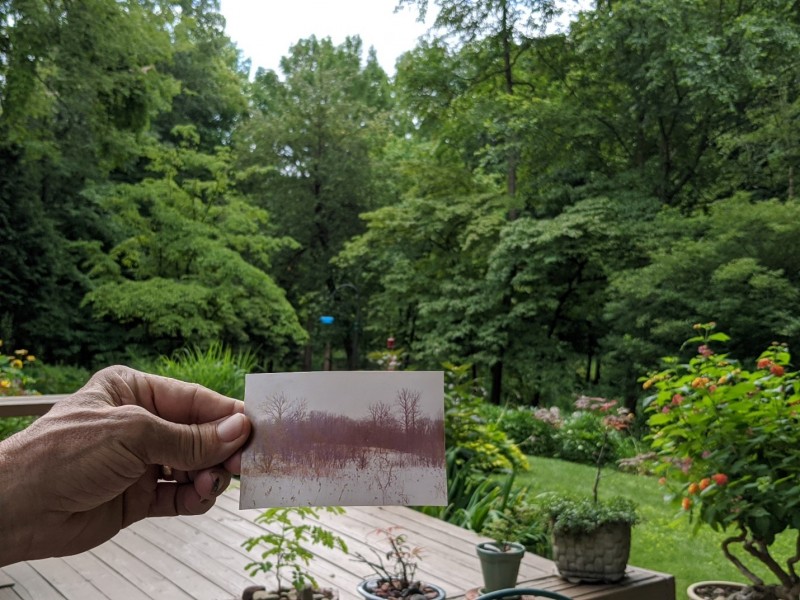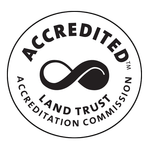News
The Power of Presence
Ninety-six percent of Indiana is privately owned. Landowners are crucial participants in healing and managing the landscape for the benefit of native species. Each landowner managing their land with plants and animals in mind is providing an important piece in the vitality of the broader natural landscape.
“I didn’t have a master plan,” George Parker admitted, “other than I wanted to minimize the amount that I actually had to mow.” In 1971, when George and Mary Lee Parker bought their property, it had been heavily grazed and dominated by blackberry brambles. They immediately planted 1,500 Christmas trees to generate income, working around patches of things George thought were important, and watched as the surrounding flora continued to develop. Fifty years later, the Parker property hosts close to 50 of Indiana’s native tree species, maples fit for tapping, red fox, weasels, flying squirrels, and nesting sites for countless species of birds. Released from the constraints of agricultural management and with a guiding hand, the land has rewilded itself.
“Out of the total 8.5 acres we now own,” George said, “probably less than an acre has been impacted or not allowed to grow naturally. But my hands are still in all of it in terms of directing it a little bit.” He has removed honeysuckle, built a retention pond, burned the prairie and planted natives like leatherwood, dogwood, and white pine. The biotic diversity is startling proof that guidance and time can make a habitat out of seemingly nondescript land.
“It makes a difference if you know what you’re looking at,” George said. “My experience in ecology—I was at Purdue for 37 years teaching forest ecology, dendrology, management of forests—that background really determines what people see when they look at the natural landscape.
It’s hard to know how other people might have reacted to the same property,” he said, standing in front of a forest that might have been mowed. “I saw this potential of what it could be and have tried to add to it over time.”
Less than a half-mile away from the Parker’s property, Jill Evans has been adding and taking away from her 14-acre property to help native species regain control of the ecosystem. Her land is another humble yet essential plot of private ownership extending the positive impact on natural habitats.
“Oh, it’s the most amazing thing!” Jill stood in her backyard with her border collies under a silver maple, peering at the ground that sprouts countless wonders. “Right here, all the way through the moss is now covered with spring beauty. One year I decided I’m not going to mow and let it go to seed, so every year it gets bigger and bigger and bigger,” she said. “And prairie trillium popped up in my yard here in the last couple years. So, I’m letting things take over!”
Jill’s property is continually progressing and, like anyone connected with their land, she anticipates its impermanent nature. She talked of the woodland oaks that over shaded her pussytoes and firepinks, and of the viburnum slowly demanding more space in her yard. She pulls out once-planted nonnatives like wintercreeper and vinca and adds native hardwoods, sedges, grasses, and flowers in their place. With a psychology degree and a horticultural background, she describes herself as a generalist who is learning and unlearning, planting and replacing nonnatives to bring her property to an improved native state.
“There’s a lot to take care of for one person,” Jill admitted. A few years ago, Jill hired a retired neighbor to help remove mature honeysuckle and treat resprouts.
“Having the ability to provide opportunities for life to happen is just really gratifying,” she said. “I hope whoever comes after me will continue. I might make it a stipulation,” she added with a laugh. “This land is a gift that we’ve been given,” she said, leaning on the gate of her tree enclosed driveway, “so we want to make it better. Better than when we got here.”
Less than a quarter of a mile down the lane from Jill’s property, Jim and Liz Solberg are on a focused pursuit to improve their 10 acres. For these landowners, “pristine” is used as a verb. Distinct lines separate the pristine forest from jungles of honeysuckle along their ⅔ miles of trails. Pristining happens through a deliberate process of pulling and clipping sprouts, cutting larger bushes with a chainsaw, and dabbing stumps with glyphosate, bringing more than sunlight to the ground.
“In addition to the aesthetic benefit,” Liz said “it’s what’s keeping us healthy. It is such a crucial part of keeping us both happy and healthy.”
The Solberg’s bought their property in 1971 when it was primarily pasture and hayfield but didn’t start managing for invasives until their retirement a decade ago.



